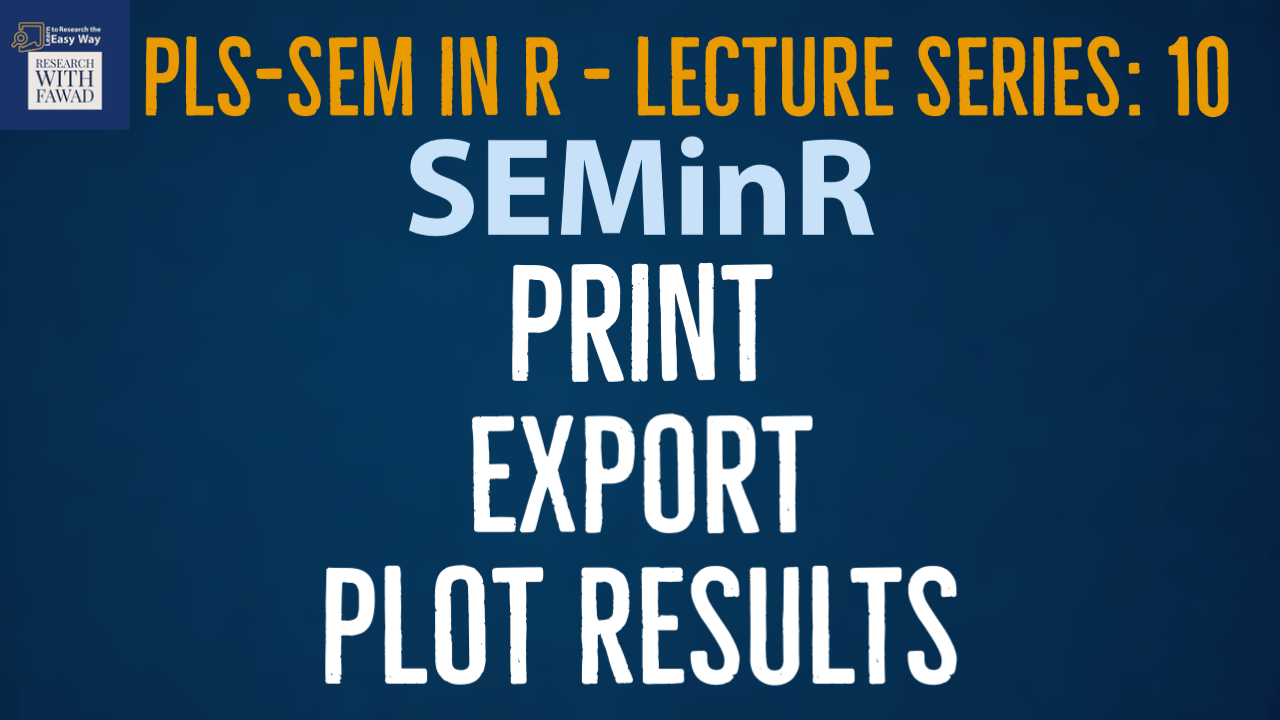Print, Export, and Plot PLS Results in SEMinR

Learn to Print, Export, and Plot PLS Results
This series of lecture on SEMinR Package will introduce the SEMinR package.
SEMinR
There are four steps to specify and estimate a structural equation model using SEMinR:
- Loading and cleaning the data
- Specifying the measurement models
- Specifying the structural model
- Estimating, bootstrapping, and summarizing the model
Review of the Steps
- When model estimation, evaluation, and analysis have been completed, it is often necessary to export the results generated in R to a report. It is recommended that tables and matrices are exported to .csv files.
- The write.csv() function takes an object and writes it into a .csv file in the working directory of the project.
- This function applies two arguments: x is the name of the object to be written to file, and file is the name of the file to be created and written to.
- Thus, if we wish to report the bootstrapped paths from the previously discussed simple model, we would use the write.csv() function with argument x = summary_boot$bootstrapped_loadings and file = “boot_loadings.csv”.
Plots
- When plotting the results, use plot() function as shown in the figure below with command plot (summary_simple$reliability) to extract the reliability plot.
- Next, we discuss how to generate high-quality figures from the SEMinR results.
- First, we generate a sample plot for export from RStudio. To do this, we use a sub-object of summary_simple and plot the constructs’ internal consistency reliabilities (i.e., Cronbach’s alpha, rhoA, and rhoC) with
plot(summary_simple$reliability)
- Once this plot displays in the plots tab in RStudio (Fig), click the Export dropdown list and select Save as PDF to bring up the save plot as a .pdf window. Select the size and output name and save the document.
Measurement and Structural Model in SEMinR
- When plotting the results, use plot() function as shown in the figure below.
- In simple terms in the plot function provide, simple_model or boot_model as arguments. Both are the estimated models. simple_model is the estimated pls model whereas boot_model is the bootstrapped model.
Review of the Steps
Following is a brief review of the steps that have been discussed in SEMinR tutorials.
- Load the Library – library ()
- Load the Data – read.csv
- Review the Data – head()
- Specify the Measurement Model – constructs()
- Specify the Structural Model – relationships()
- Estimate the Model – estimate_pls()
- Summarize the Results – summary()
- Bootstrap the Model – bootstrap_model()
- Summarize the Results – summary()
The next step is Plotting and Writing Results – plot() and Write.csv
Complete Code
#load the library
library(seminr)
# Load the Data
datas <- read.csv(file = "Data.csv", header = TRUE, sep = ",")
head(datas)
# Create measurement model
simple_mm <- constructs(
composite("Vision", multi_items("VIS", 1:4)),
composite("Development", multi_items("DEV", 1:7)),
composite("Rewards", multi_items("RW",1:4)),
composite("Collaborative Culture", multi_items("CC", 1:6)))
# Create structural model
simple_sm <- relationships(
paths(from = c("Vision", "Development", "Rewards"), to = "Collaborative Culture"))
# Estimate the model
simple_model <- estimate_pls(data = datas,
measurement_model = simple_mm,
structural_model = simple_sm)
# Summarize the model results
summary_simple <- summary(simple_model)
#Retreive Full Summary
summary_simple
# Inspect the model path coefficients and the R^2 values
summary_simple$paths
# Inspect the construct reliability metrics
summary_simple$reliability
# Bootstrap the model
boot_simple <- bootstrap_model(seminr_model = simple_model,
nboot = 1000,
cores = NULL,
seed = 123)
# Store the summary of the bootstrapped model
summary_boot <- summary(boot_simple)
#Retreive Full Report
summary_boot
# Inspect the bootstrapped structural paths
summary_boot$bootstrapped_paths
# Inspect the bootstrapped indicator loadings
Summary_boot $bootstrapped_loadings
#Generating Plots
plot(simple_model)
plot(summary_simple$reliability)
plot(boot_simple)
# Write the bootstrapped paths object to csv file
write.csv(x = summary_boot$bootstrapped_loadings, file = "boot_loadings.csv")Reference
Hair Jr, J. F., Hult, G. T. M., Ringle, C. M., Sarstedt, M., Danks, N. P., & Ray, S. (2021). Partial Least Squares Structural Equation Modeling (PLS-SEM) Using R: A Workbook.
The tutorials on SEMinR are based on the mentioned book. The book is open source and available for download under this link.
Video Tutorial
Additional SEMinR Tutorials
- An Introduction to R and R Studio
- An Introduction to SEMinR Package
- Create Project, Load, and Inspect the Data
- SEMinR Package: An Introduction to Evaluating Formative Measurement Model
- SEMinR Package: Analyzing Categorical Predictor Variables
- SEMinR Package: Bootstrapping PLS Model
- SEMinR Package: Evaluating Formative Measurement Model – Convergent Validity and Collinearity
- SEMinR Package: Evaluating Formative Measurement Model – Step 3- Indicator Weights
- SEMinR Package: Evaluating Formative Measurement Model – When to Delete Formative Indicators
- SEMinR Package: Evaluating Reflective Measurement Model
- SEMinR Package: Evaluating Structural Model
- SEMinR Package: Evaluating Structural Model – Step 4: Predictive Power (PLSPredict)
- SEMinR Package: Higher Order Analysis – REF-FOR
- SEMinR Package: Higher Order Analysis – REF-REF
- SEMinR Package: How to Solve Convergent and Discriminant Validity Problems
- SEMinR Package: Mediation Analysis
- SEMinR Package: Moderation Analysis
- SEMinR Package: PLS Estimation
- SEMinR Package: Reflective Measurement Model Step 2: Consistency and Step 3: Convergent Validity
- SEMinR Package: Reflective Measurement Model Step 4: Discriminant Validity
- SEMinR Package: Single Item, SmartPLS Comparison and Summary of SEMinR
- SEMinR Package: Specifying Measurement Model
- SEMinR Package: Specifying the Structural Model